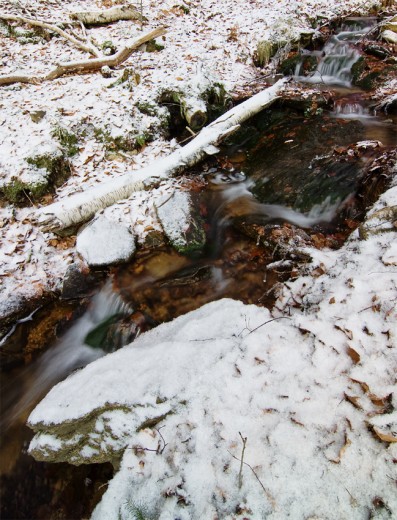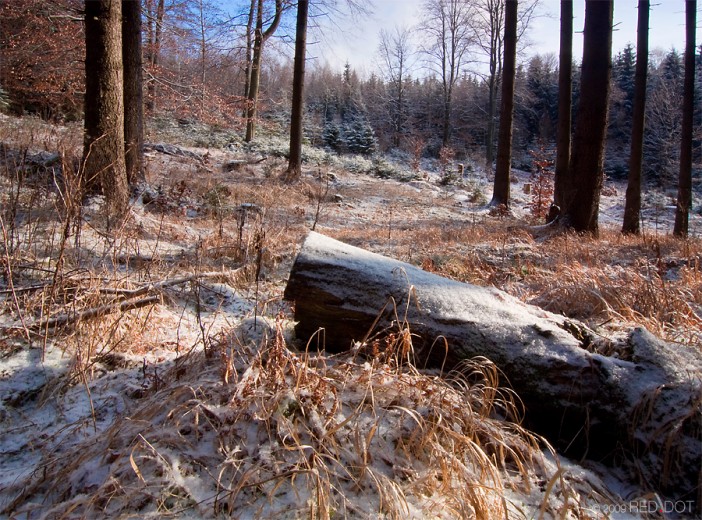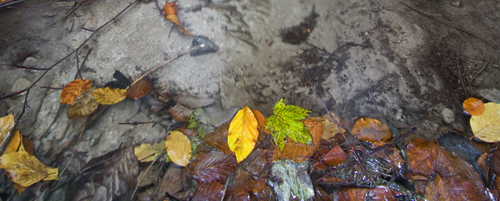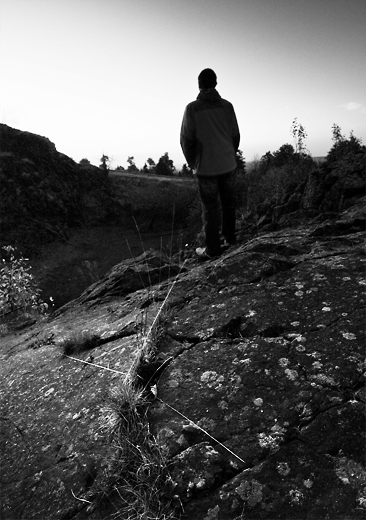Archive for the ‘Landscape Photography’ Category
The Struggles of Winter
01
Feb
2010
Where has the time, in particular the January, gone? While I am unsure as to where it went, I feel obliged to let you know what I have been up to lately. As you might have recognized, shooting was not one of the things I have done in abundance but I did have a few fun shoots. Most of the time was spent with planning for the upcoming trip to the US in the summer months and working on presentations and the like for such “lame” things as marketing and market research, finance or business history. Being a full-time student, the time right before the exams is the busiest time of the semester and this is right NOW.
Anyhow, since I mostly wanted to talk about photography, here we go. After a rather brown and gray November and December, which given a normal year, are rather white then brown and muddy, it was the January that finally brought me the snow I was hoping for for quite some time.
But with the approaching snow, the good light faded more and more and instead of watching amazing sunrises and sunsets I’ve been constantly greeted with uniform, dull skies but these did not stop my from trying, to some extent.
The first image I want to share was taken on a hike I took earlier in the year. The fresh snow and below zero temperatures created an interesting backdrop for the single tree standing on the wide open range. The hoarfrost on the twigs resulted in a great contrast to the dark, ominous sky.
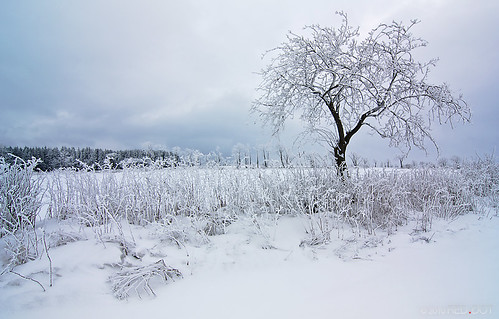
Canon Rebel XSi with Tokina 11-16mm f/2.8 @ 11mm, 1/5sec, f/14.
Next in line is a study of the complex birch tree covered in heavy rime ice. A scene that is easily overseen by many but in situations of longer periods of bad light you learn to appreciate details and abstract views.
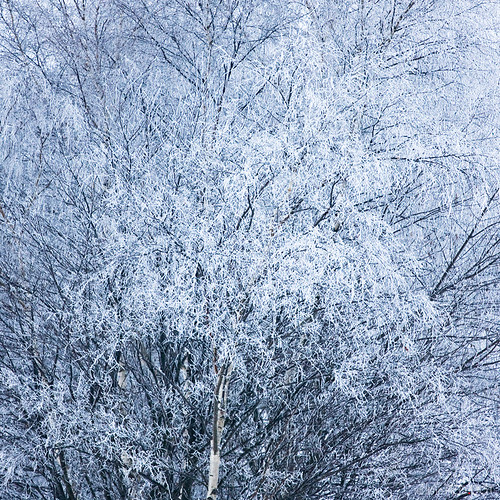
Canon Rebel XSi with EF Canon 70-200mm f/4L @ 200mm, 1/400sec, f/4, ISO400.
I have never been a wildlife photographer but as of late, blame it on the light and Canon for making incredible sharp lenses, I have learned to love avian photography. Photographing birds requires a completely different set of skills than landscape photography. Who would have thunk? I can see though how these two fields of photography complement each other and how learning and experimenting in one field can lead to an improvement in other fields of photography. Both, landscape and avian photography, require patience but then are completely different. When hiking and shooting in the mountains, shooting lakes and the like, it’s all about light, you “simply” have to wait out the bad light and hope the magical two minutes will happen. Shooting birds is different, your mind has to be in a constant hunting mode. Every second the bird can pop out through the branches and be gone a second or two later. There’s no reading books, no walking around, jumping up and down to keep you warm. It’s a tiring battle with critters weighing as much as an USB stick.
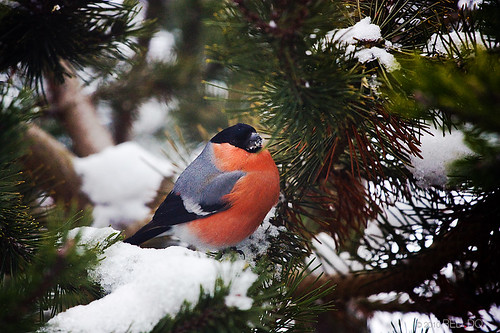
Canon Rebel XSi with EF Canon 70-200mm f/4L @ 200mm, 1/500sec, f/4, ISO400.
The shot above is of an Eurasian Bullfinch (Pyrrhula pyrrhula) in a thick forest of pines and easily the most colorful thing I have photographed all winter long. Getting this shot required even more than a little luck and patience. It almost cost me an eye to get close to the bird, crawling through the lower branches of pine trees to catch this beautiful male bird. Pine needles are weapons and should be put under restrictions. All kidding aside, Eurasian Bullfinchs are truly a challenge. They easily rank in the first spot when it comes to shy birds (which I tried to shoot) and are usually gone with the slightest unexpected movement or sound. Or maybe I should get some fancy pine and spruce branches to build my very own camouflage hat?

Canon Rebel XSi with EF Canon 70-200mm f/4L @ 200mm, 1/800sec, f/5.6, ISO400.
Another bird image and the last for today features a small younger Blue Tit (Cyanistes caeruleus) resting on a twig of a whitethorn bush.
Next challenge: Bohemian Waxwing (Bombycilla garrulus) if they will ever come that far south.
Since I promised to include a short trip report from yesterday on my flickr page, please prepare yourself for another episode of: “Photo-G goes Wild. Raw and unfiltered.”
Being greeted with clear blue skies I decided it was finally time for an extended skiing trip through the forests and fields around home. I had planned to go for two hours, shoot along the way and maybe extend it to three hours. What I did not plan happened. I left after a delicious lunch with green Thai curry and to blow it off (pun intended), no, this was not part of the problem. After passing the first mountain ridge and skiing downhill into the forest where I expected to see some wildlife, the blue sky was completely gone and a snow storm started to kick in. Thinking of nothing bad I proceeded through the forest up and down the slopes, finally arriving at the river where I hoped to see, if not photograph, Common Kingfishers and White-throated Dippers which usually are easier to spot now than in the summer due to the few remaining open spots in the river. While I did not see any Kingfishers I was able to spot one Dipper along the way and let me say this, it is truly an amazing animal. Diving into the ice cold water of the fast flowing river in search of little fly larva and other critters. I applaud you White-throated Dipper! If it was me, I’d have backed out. To cut it short, I was caught in a major snowstorm on my way back home, I missed my dear deer Janet and Janice standing only 30 or so feet away due to the high winds that were blowing snow in my face like mad and if that wasn’t enough punishment, I had to find my way home in the pitch-black dark without a headlamp – on skis two inch wide. Fun! I am sure there are more episodes to be shared.
Happy shooting my friends, fellow photographers and nature lovers!
David
01
Feb
2010
Where has the time, in particular the January, gone? While I am unsure as to where it went, I feel obliged to let you know what I have been up to lately. As you might have recognized, shooting was not one of the things I have done in abundance but I did have a few fun shoots. Most of the time was spent with planning for the upcoming trip to the US in the summer months and working on presentations and the like for such “lame” things as marketing and market research, finance or business history. Being a full-time student, the time right before the exams is the busiest time of the semester and this is right NOW.
Anyhow, since I mostly wanted to talk about photography, here we go. After a rather brown and gray November and December, which given a normal year, are rather white then brown and muddy, it was the January that finally brought me the snow I was hoping for for quite some time.
But with the approaching snow, the good light faded more and more and instead of watching amazing sunrises and sunsets I’ve been constantly greeted with uniform, dull skies but these did not stop my from trying, to some extent.
The first image I want to share was taken on a hike I took earlier in the year. The fresh snow and below zero temperatures created an interesting backdrop for the single tree standing on the wide open range. The hoarfrost on the twigs resulted in a great contrast to the dark, ominous sky.

Canon Rebel XSi with Tokina 11-16mm f/2.8 @ 11mm, 1/5sec, f/14.
Next in line is a study of the complex birch tree covered in heavy rime ice. A scene that is easily overseen by many but in situations of longer periods of bad light you learn to appreciate details and abstract views.

Canon Rebel XSi with EF Canon 70-200mm f/4L @ 200mm, 1/400sec, f/4, ISO400.
I have never been a wildlife photographer but as of late, blame it on the light and Canon for making incredible sharp lenses, I have learned to love avian photography. Photographing birds requires a completely different set of skills than landscape photography. Who would have thunk? I can see though how these two fields of photography complement each other and how learning and experimenting in one field can lead to an improvement in other fields of photography. Both, landscape and avian photography, require patience but then are completely different. When hiking and shooting in the mountains, shooting lakes and the like, it’s all about light, you “simply” have to wait out the bad light and hope the magical two minutes will happen. Shooting birds is different, your mind has to be in a constant hunting mode. Every second the bird can pop out through the branches and be gone a second or two later. There’s no reading books, no walking around, jumping up and down to keep you warm. It’s a tiring battle with critters weighing as much as an USB stick.

Canon Rebel XSi with EF Canon 70-200mm f/4L @ 200mm, 1/500sec, f/4, ISO400.
The shot above is of an Eurasian Bullfinch (Pyrrhula pyrrhula) in a thick forest of pines and easily the most colorful thing I have photographed all winter long. Getting this shot required even more than a little luck and patience. It almost cost me an eye to get close to the bird, crawling through the lower branches of pine trees to catch this beautiful male bird. Pine needles are weapons and should be put under restrictions. All kidding aside, Eurasian Bullfinchs are truly a challenge. They easily rank in the first spot when it comes to shy birds (which I tried to shoot) and are usually gone with the slightest unexpected movement or sound. Or maybe I should get some fancy pine and spruce branches to build my very own camouflage hat?

Canon Rebel XSi with EF Canon 70-200mm f/4L @ 200mm, 1/800sec, f/5.6, ISO400.
Another bird image and the last for today features a small younger Blue Tit (Cyanistes caeruleus) resting on a twig of a whitethorn bush.
Next challenge: Bohemian Waxwing (Bombycilla garrulus) if they will ever come that far south.
Since I promised to include a short trip report from yesterday on my flickr page, please prepare yourself for another episode of: “Photo-G goes Wild. Raw and unfiltered.”
Being greeted with clear blue skies I decided it was finally time for an extended skiing trip through the forests and fields around home. I had planned to go for two hours, shoot along the way and maybe extend it to three hours. What I did not plan happened. I left after a delicious lunch with green Thai curry and to blow it off (pun intended), no, this was not part of the problem. After passing the first mountain ridge and skiing downhill into the forest where I expected to see some wildlife, the blue sky was completely gone and a snow storm started to kick in. Thinking of nothing bad I proceeded through the forest up and down the slopes, finally arriving at the river where I hoped to see, if not photograph, Common Kingfishers and White-throated Dippers which usually are easier to spot now than in the summer due to the few remaining open spots in the river. While I did not see any Kingfishers I was able to spot one Dipper along the way and let me say this, it is truly an amazing animal. Diving into the ice cold water of the fast flowing river in search of little fly larva and other critters. I applaud you White-throated Dipper! If it was me, I’d have backed out. To cut it short, I was caught in a major snowstorm on my way back home, I missed my dear deer Janet and Janice standing only 30 or so feet away due to the high winds that were blowing snow in my face like mad and if that wasn’t enough punishment, I had to find my way home in the pitch-black dark without a headlamp – on skis two inch wide. Fun! I am sure there are more episodes to be shared.
Happy shooting my friends, fellow photographers and nature lovers!
David
Happy Holidays!
25
Dec
2009
I just wanted to wish you all a Merry Christmas and some great Holidays with family, friends and whomever you will spend your time with. If you have some fresh snow, go out and take a walk to enjoy the beauty of it and do not take it for granted.
For years I believed to live in a snow-safe area but since the dry and cold air masses from Russia stopped colliding with the wet ones moving in from the UK, we seem to have a hard time around Christmas each year, snow-wise speaking. We had a good cover already, something to build up on, but right in the middle of Christmas Eve the thermometer revealed 41F/5C which is a major disappointment.
Anyhow, after the break, I’ll be back to Dresden to shoot the city with Mr. Blue Hour himself, Mr. David Bank, flying straight in from London. Really looking forward to that and I am in high hopes the weather will cooperate.
I’ll leave you with an old favorite of mine. A square crop from one of the majestic winter sunsets I have witnessed. Standing atop the highest mountain in the region let’s you reflect on the past but also makes you look forward to the great things to conquer in the days, weeks and months to come, so now I said it, I am looking forward to 2010 but I will cover my excitement with the New Year’s post.
Until then, happy shooting! Never stop exploring! 😉
David
25
Dec
2009
I just wanted to wish you all a Merry Christmas and some great Holidays with family, friends and whomever you will spend your time with. If you have some fresh snow, go out and take a walk to enjoy the beauty of it and do not take it for granted.
For years I believed to live in a snow-safe area but since the dry and cold air masses from Russia stopped colliding with the wet ones moving in from the UK, we seem to have a hard time around Christmas each year, snow-wise speaking. We had a good cover already, something to build up on, but right in the middle of Christmas Eve the thermometer revealed 41F/5C which is a major disappointment.
Anyhow, after the break, I’ll be back to Dresden to shoot the city with Mr. Blue Hour himself, Mr. David Bank, flying straight in from London. Really looking forward to that and I am in high hopes the weather will cooperate.
I’ll leave you with an old favorite of mine. A square crop from one of the majestic winter sunsets I have witnessed. Standing atop the highest mountain in the region let’s you reflect on the past but also makes you look forward to the great things to conquer in the days, weeks and months to come, so now I said it, I am looking forward to 2010 but I will cover my excitement with the New Year’s post.
Until then, happy shooting! Never stop exploring! 😉
David
A Visit To Lower Loop
15
Dec
2009
With Christmas just around the corner and the holiday machinery running full force, it was about time the mountains finally saw some snow and I admit, I too was pretty happy when I saw the forecast for the past weekend. A sudden temperature drop to 10 degrees prevented a thick cover though, that I was hoping for, but a nice white dusting veiled the mountains.
Sunday morning I made my way out to a spot I haven’t been before but knew it was going to be a great experience when I saw the trail head to an 8 mile loop up the valley through a vast forest in Germany’s Ore Mountains. Let’s say this, the first two miles are great, the rest was rather strenuous and required a little dedication.
Here’s the creek running down along the trail for the first mile or so after uniting from several really small water sources. Click on the picture for a larger view!
Canon Rebel XSi with Tokina 11-16mm f/2.8 @ 12mm, 0.8sec, f/18.
While the snow was nice to look at in person, having the appearance of powdered sugar, it was difficult to photograph since the trees do not provide any kind of natural filter this time of the year due to the lack of foliage and the low amount of snow made the scenes look cluttered but this didn’t stop me from shooting. It is December and only the second time I had snow under my feet! Nothing was going to stop me!
Another composition with countless broken tree trunks from the past winters lining up with the diagonal layers of rocks and the rushing water.
Canon Rebel XSi with Tokina 11-16mm f/2.8 @ 11mm, 0.8sec, f/20.
While I probably will not do the complete hike again, I am pretty confident to return when the creek has seen a good amount of snow and then definitely in the spring when the greens of the beeches and ferns will be glowing.
“The Remnants of the Past” were omnipresent during the whole time. Old or cut-down tree trunks adorn the trail up the mountain and the one depicted made the best foreground against a small meadow where snow and ice covered the spruces in the background, all lit up by early morning light.
Canon Rebel XSi with Tokina 11-16mm f/2.8 @ 11mm, 0.8sec, f/20.
It’s that time of the year again where the big hunt for Christmas presents falls into place and to the surprise of many I still have to hunt some good things down. So, see you later folks with part two of the past weekend.
Happy Holiday Season and cheers on a successful hunt!
David
15
Dec
2009
With Christmas just around the corner and the holiday machinery running full force, it was about time the mountains finally saw some snow and I admit, I too was pretty happy when I saw the forecast for the past weekend. A sudden temperature drop to 10 degrees prevented a thick cover though, that I was hoping for, but a nice white dusting veiled the mountains.
Sunday morning I made my way out to a spot I haven’t been before but knew it was going to be a great experience when I saw the trail head to an 8 mile loop up the valley through a vast forest in Germany’s Ore Mountains. Let’s say this, the first two miles are great, the rest was rather strenuous and required a little dedication.
Here’s the creek running down along the trail for the first mile or so after uniting from several really small water sources. Click on the picture for a larger view!
Canon Rebel XSi with Tokina 11-16mm f/2.8 @ 12mm, 0.8sec, f/18.
While the snow was nice to look at in person, having the appearance of powdered sugar, it was difficult to photograph since the trees do not provide any kind of natural filter this time of the year due to the lack of foliage and the low amount of snow made the scenes look cluttered but this didn’t stop me from shooting. It is December and only the second time I had snow under my feet! Nothing was going to stop me!
Another composition with countless broken tree trunks from the past winters lining up with the diagonal layers of rocks and the rushing water.
Canon Rebel XSi with Tokina 11-16mm f/2.8 @ 11mm, 0.8sec, f/20.
While I probably will not do the complete hike again, I am pretty confident to return when the creek has seen a good amount of snow and then definitely in the spring when the greens of the beeches and ferns will be glowing.
“The Remnants of the Past” were omnipresent during the whole time. Old or cut-down tree trunks adorn the trail up the mountain and the one depicted made the best foreground against a small meadow where snow and ice covered the spruces in the background, all lit up by early morning light.
Canon Rebel XSi with Tokina 11-16mm f/2.8 @ 11mm, 0.8sec, f/20.
It’s that time of the year again where the big hunt for Christmas presents falls into place and to the surprise of many I still have to hunt some good things down. So, see you later folks with part two of the past weekend.
Happy Holiday Season and cheers on a successful hunt!
David
Fall Color Report
08
Nov
2009
In today’s post I plan to cover the essential gear you need in your camera bag when you head out into the woods to catch the colors at their peak and hope to mix it up with some shots and maybe a little story too, but I’ll come to that later – eventually.
This year, fall did something weird with us. At first glance, I was pretty sure we skipped it completely to head straight into the cold and snowy winter which is certainly one of the most interesting and challenging seasons for us nature and landscape photographers. Not only the snow and freezing temperatures make hiking more exhausting than it is already during the rest of the year, it also needs another kind of vision because the areas you know might look totally different under a 4 or 6 feet snow cover. However, the first day of fall was here and I found myself surrounded with the first two feet snow of the year and I knew the most scenic area would be the 4000ft. peak of the Fichtelberg where winter was already in full force. (Pictures to follow in another post.) Back in my neck of the woods, the snow was already melting and to everyone’s surprise most of the leaves in the lower lying areas where still on the trees. The next weekend I packed my gear for a three hour tour in some local forests.
The first image for today was taken on a steep slope where the forest is more open than in most parts in the area. The warm afternoon sun was blasting through the tree tops of spruces, birches and a few pines which are a really rare treat to the eye. I used a small aperture to allow a longer exposure to give the foliage a somewhat abstract look while the wind was blowing through. Click on the image for the full view.
Canon Rebel XSi with Tokina 11-16mm f/2.8 @ 11mm, 2sec, f/22.
Essential for this particular image was a circular polarizer and a 3-stop soft-edge gradual neutral density filter to balance the bright sky and light hitting the upper leaves and the relatively dark foreground.
I especially find the circular polarizer extremely helpful for fall foliage images. Not only does the CPL remove reflections from the water surface and allows you to see to the bottom of a stream, it also cuts through haze and mist, which you often find in fall and it removes the glare from the foliage which will otherwise make it look dull and without the punch required to make an image really work and leave an impression on the viewer.
Without a doubt, a set of gradual neutral density filters can also be of a great help for any scene where you encounter a bright background and a relatively dark foreground. In order to achieve a balanced and well exposed photograph, you basically rely on them if you do not plan to spend a lot of time in front of a computer screen. For beginners a set of a 2-stop hard-edge and a 3-stop soft-edge should handle most scenes quite well. I’ll cover the idea behind neutral density filters in a future post more extensively. If you have any questions though, please feel free to leave a comment with your question.
The next image is called “Dead Warriors” since those old spruces lined up there in such a dense manner, it seemed impossible to break through the defensive line to the magical place that lies behind. Or it might just have been more of the impassible thicket. I did not put to much thought into that and wandered on. Click on the image for full view.
Canon Rebel XSi with Tokina 11-16mm f/2.8 @ 16mm, 0.6sec, f/11.
Last for today is a little cascading waterfall which I shot already the year before but the spring flooding changed the layout quite a bit and it was rather hard to find a good composition. A little upstream I saw these bright colored leaves swirling around a little pool and set up tripod. A 20-second exposure was needed to ensure a proper exposed and lit scene. Click on the image for full view.
Canon Rebel XSi with Tokina 11-16mm f/2.8 @ 11mm, 20sec, f/8.
I’ll be off to a nice little stream tomorrow to catch the remaining color in the trees before the winter really kicks in. Stay tuned for part two of the report.
David
08
Nov
2009
In today’s post I plan to cover the essential gear you need in your camera bag when you head out into the woods to catch the colors at their peak and hope to mix it up with some shots and maybe a little story too, but I’ll come to that later – eventually.
This year, fall did something weird with us. At first glance, I was pretty sure we skipped it completely to head straight into the cold and snowy winter which is certainly one of the most interesting and challenging seasons for us nature and landscape photographers. Not only the snow and freezing temperatures make hiking more exhausting than it is already during the rest of the year, it also needs another kind of vision because the areas you know might look totally different under a 4 or 6 feet snow cover. However, the first day of fall was here and I found myself surrounded with the first two feet snow of the year and I knew the most scenic area would be the 4000ft. peak of the Fichtelberg where winter was already in full force. (Pictures to follow in another post.) Back in my neck of the woods, the snow was already melting and to everyone’s surprise most of the leaves in the lower lying areas where still on the trees. The next weekend I packed my gear for a three hour tour in some local forests.
The first image for today was taken on a steep slope where the forest is more open than in most parts in the area. The warm afternoon sun was blasting through the tree tops of spruces, birches and a few pines which are a really rare treat to the eye. I used a small aperture to allow a longer exposure to give the foliage a somewhat abstract look while the wind was blowing through. Click on the image for the full view.
Canon Rebel XSi with Tokina 11-16mm f/2.8 @ 11mm, 2sec, f/22.
Essential for this particular image was a circular polarizer and a 3-stop soft-edge gradual neutral density filter to balance the bright sky and light hitting the upper leaves and the relatively dark foreground.
I especially find the circular polarizer extremely helpful for fall foliage images. Not only does the CPL remove reflections from the water surface and allows you to see to the bottom of a stream, it also cuts through haze and mist, which you often find in fall and it removes the glare from the foliage which will otherwise make it look dull and without the punch required to make an image really work and leave an impression on the viewer.
Without a doubt, a set of gradual neutral density filters can also be of a great help for any scene where you encounter a bright background and a relatively dark foreground. In order to achieve a balanced and well exposed photograph, you basically rely on them if you do not plan to spend a lot of time in front of a computer screen. For beginners a set of a 2-stop hard-edge and a 3-stop soft-edge should handle most scenes quite well. I’ll cover the idea behind neutral density filters in a future post more extensively. If you have any questions though, please feel free to leave a comment with your question.
The next image is called “Dead Warriors” since those old spruces lined up there in such a dense manner, it seemed impossible to break through the defensive line to the magical place that lies behind. Or it might just have been more of the impassible thicket. I did not put to much thought into that and wandered on. Click on the image for full view.
Canon Rebel XSi with Tokina 11-16mm f/2.8 @ 16mm, 0.6sec, f/11.
Last for today is a little cascading waterfall which I shot already the year before but the spring flooding changed the layout quite a bit and it was rather hard to find a good composition. A little upstream I saw these bright colored leaves swirling around a little pool and set up tripod. A 20-second exposure was needed to ensure a proper exposed and lit scene. Click on the image for full view.
Canon Rebel XSi with Tokina 11-16mm f/2.8 @ 11mm, 20sec, f/8.
I’ll be off to a nice little stream tomorrow to catch the remaining color in the trees before the winter really kicks in. Stay tuned for part two of the report.
David
Winter Is Approaching Fast
17
Oct
2009
Okay folks,
it took me quite a bit for my third post. I’d like to apologize for that. University has started for me and the schedule is less than photography friendly. Not just that university would get into the way, it’s more or less not the weather for photography. The images I pre-visualized for the fall with colorful trees were soon replaced by winterly landscapes. This basically means we have the first snow of the season and before the leaves could actually turn yellow and red, the show was over and it had not even started yet. As much as I look forward to winter and deep powdery snow, I am pretty disappointed to say the least. I still have a lot of pictures to process and to evaluate which to process at all from the past months though and this will keep me quite busy I suppose. Tomorrow I will visit one of my favorite local spots. The shot below is certainly one of my favorites from last year. A cold but fiery sunset at 4000 ft. above the sea level.
The next two images showcase a spot I also plan to visit more frequently. The basaltic formations offer quite a few compositions and I only have been to this place once for some self portraits and did not really care for the landscape part.
Until next week, happy shooting everybody!
17
Oct
2009
Okay folks,
it took me quite a bit for my third post. I’d like to apologize for that. University has started for me and the schedule is less than photography friendly. Not just that university would get into the way, it’s more or less not the weather for photography. The images I pre-visualized for the fall with colorful trees were soon replaced by winterly landscapes. This basically means we have the first snow of the season and before the leaves could actually turn yellow and red, the show was over and it had not even started yet. As much as I look forward to winter and deep powdery snow, I am pretty disappointed to say the least. I still have a lot of pictures to process and to evaluate which to process at all from the past months though and this will keep me quite busy I suppose. Tomorrow I will visit one of my favorite local spots. The shot below is certainly one of my favorites from last year. A cold but fiery sunset at 4000 ft. above the sea level.
The next two images showcase a spot I also plan to visit more frequently. The basaltic formations offer quite a few compositions and I only have been to this place once for some self portraits and did not really care for the landscape part.
Until next week, happy shooting everybody!



